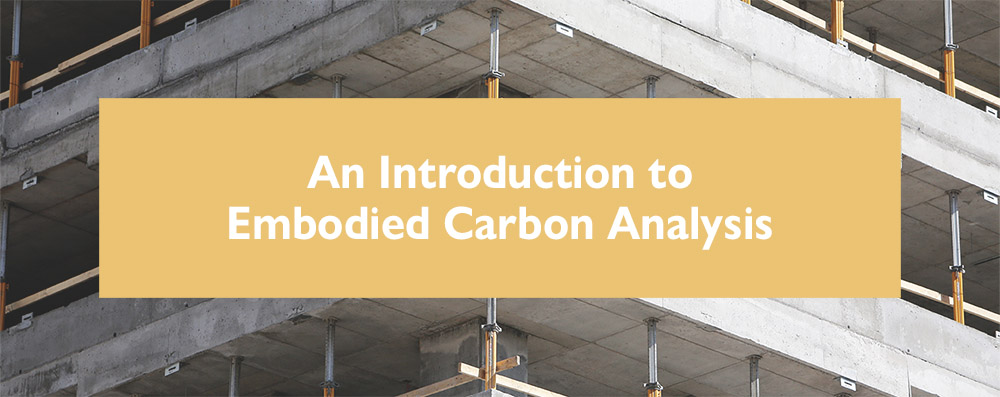How do I Reduce Embodied Carbon in My Building?
By Amy Johns, Senior Strategy Consultant
“Embodied carbon” refers to the greenhouse gases released in the manufacturing and transportation of something. As a rule of thumb, if a material requires combustion or melting in its manufacturing (think glass, concrete, steel), it’s high in embodied carbon. Plant-based materials tend to be lower in embodied carbon—or even carbon sequestering, depending on the supply chain.
When it comes to building projects, embodied carbon is increasingly recognized as a critical part of climate action. Manufacturing construction materials accounts for 11% of global emissions. While that’s currently smaller than the 28% of global emissions coming from building operations, in new construction the percentage of impact from embodied carbon is much higher than in existing buildings, due to increased attention to reducing operating energy.
If your organization wants to reduce embodied carbon in your building projects, what can you do? That depends on your project. On the surface, it would seem obvious that new construction has much higher embodied carbon than renovation, given the amount of new materials involved. Below the surface, things are more complicated.
Renovations vary tremendously in scope. The closer a renovation gets to a “full gut” (where a building is basically stripped down to its structure), the closer the embodied carbon emissions become, when comparing the renovation with comparable new construction. Code-required improvements, deep energy retrofits and fixing structural problems in older buildings can all increase embodied carbon in a renovation. New construction can almost always achieve higher levels of energy efficiency than renovations, so the life cycle climate impact of an intense renovation and new construction can be quite close.
The best way to answer the question of whether new construction or renovation is preferable from a climate perspective is do a life cycle carbon scenario analysis of both possibilities. This is complicated, since the moment that most owners are making the choice between new construction and renovation is often well before there’s enough of a design to really do a life cycle analysis. You can solve this problem several ways; for readers facing this issue, we offer strategies for making this assessment.
Ultimately, you may even decide on renovation or new construction based on other factors, but commit to prioritizing low-carbon construction in the chosen scenario. Depending on the project, careful decisions in either a renovation or new construction may be more important for climate impact than whether you undertake one or the other.
As with many aspects of sustainability in building projects, the biggest carbon impact comes from decisions made fairly early in the design process. Some questions to ask:
- How big is the building? The smaller, the better.
- What’s the construction type? Wood structures are much lower in embodied carbon than steel-and-concrete.
- How much glass is there? Glass is high in embodied carbon (and low in R-value).
A right-sized wood structure with sufficient (but not excessive) amounts of glass is much lower carbon than a huge curtain wall steel-and-concrete building.
Key to success is hiring a design and construction team experienced in delivering low-carbon building projects. A team that is genuinely engaged in reducing embodied carbon will make all other steps easier. Be clear about what you’re asking for in a project—address the issue in the RFP/RFQ.
If you’re debating between new construction and renovation, be clear both internally and with your design team about which method you’re using (see strategies above). If you know that your project is new construction, either ask outright for low carbon construction type (dictate wood structure and appropriate glass) or ask for scenario life cycle carbon analysis of possible structure types and glass percentages.
If you know that your project is renovation, embodied carbon is less likely to drive decision making since the basic structure, glass percentage and size are already determined. If there’s a substantial addition, follow the recommendations above for new construction.
Be willing to push back on designs that are not low carbon. Ideally, you’ve hired a design team that proactively presents you with low-carbon designs, but if you haven’t, then reject designs with soaring glass atriums, lots of curtain wall and concrete.
Finally, consider carbon pricing as a way of balancing embodied carbon concerns with other priorities in the project. Many decisions that impact embodied carbon are low cost, save money or are difficult to cost. What, for example, is the cost of making an early design choice to reduce glass? Carbon pricing can be used, especially later in design, to prioritize low carbon choices of individual materials.
Amy Johns, IES senior strategy consultant, is the former director of the Zilkha Center for Environmental Initiatives at Williams College. She has worked in the environmental sector for more than fifteen years.
Copyright © Integrated Eco Strategy, LLC



